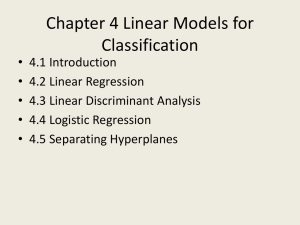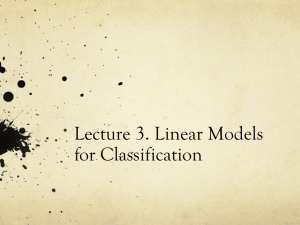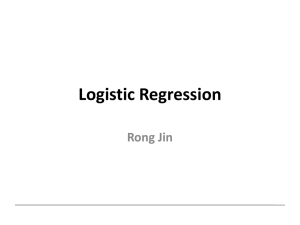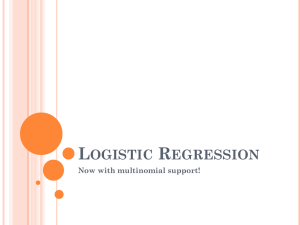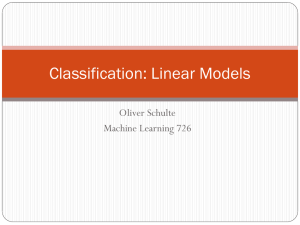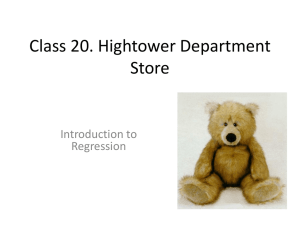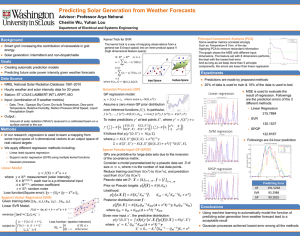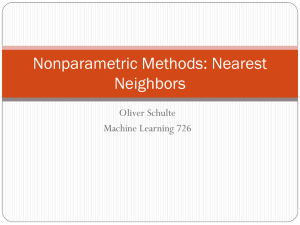Lec_8n9_LinearClass2
advertisement
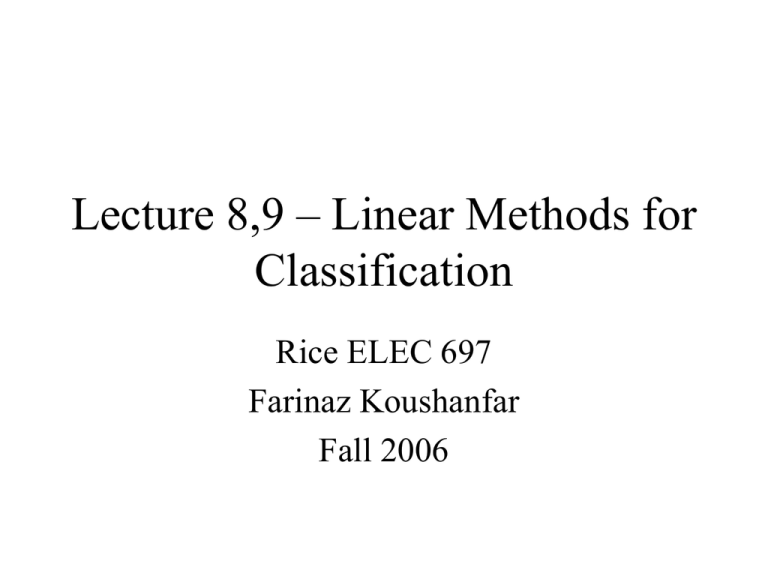
Lecture 8,9 – Linear Methods for
Classification
Rice ELEC 697
Farinaz Koushanfar
Fall 2006
Summary
•
•
•
•
•
•
•
Bayes Classifiers
Linear Classifiers
Linear regression of an indicator matrix
Linear discriminant analysis (LDA)
Logistic regression
Separating hyperplanes
Reading (ch4, ELS)
Bayes Classifier
• The marginal distributions of G are specified as PMF
pG(g), g=1,2,…,K
• fX|G(x|G=g) shows the conditional distribution of X
for G=g
• The training set (xi,gi),i=1,..,N has independent
samples from the joint distribution fX,G(x,g)
– fX,G(x,g) = pG(g)fX|G(x|G=g)
• The loss of predicting G* for G is L(G*,G)
• Classification goal: minimize the expected loss
– EX,GL(G(X),G)=EX(EG|XL(G(X),G))
Bayes Classifier (cont’d)
• It suffices to minimize EG|XL(G(X),G) for each
X. The optimal classifier is:
– G(x) = argmin g EG|X=xL(g,G)
Bayes classification rule
• The Bayes rule is also known as the rule of
maximum a posteriori probability
– G(x) = argmax g Pr(G=g|X=x)
• Many classification algorithms estimate the
Pr(G=g|X=x) and then apply the Bayes rule
More About Linear Classification
• Since predictor G(x) take values in a discrete set G,
we can divide the input space into a collection of
regions labeled according to classification
• For K classes (1,2,…,K), and the fitted linear model
for k-th indicator response variable is
T
ˆ
ˆ
ˆ
f
(
x
)
• k
k0
kx
• The decision boundary b/w k and l is: fˆk ( x) fˆl ( x)
• An affine set or hyperplane:
ˆ
ˆ ) (
ˆ
ˆ )T x 0}
{x : (
k0
l0
k
l
• Model discriminant function k(x) for each class, then
classify x to the class with the largest value for k(x)
Linear Decision Boundary
• We require that monotone transformation of k or
Pr(G=k|X=x) be linear
• Decision boundaries are the set of points with log-odds=0
• Prob. of class 1: , prob. of class 2: 1-
• Apply a transformation:: log[/(1- )]=0+ Tx
• Two popular methods that use log-odds
– Linear discriminant analysis, linear logistic regression
• Explicitly model the boundary b/w two classes as linear. For a
two-class problem with p-dimensional input space, this is
modeling decision boundary as a hyperplane
• Two methods using separating hyperplanes
– Perceptron - Rosenblatt, optimally separating hyperplanes - Vapnik
Generalizing Linear Decision
Boundaries
• Expand the variable set X1,…,Xp by including squares and
cross products, adding up to p(p+1)/2 additional variables
Linear Regression of an Indicator
Matrix
• For K classes, K indicators Yk, k=1,…,K, with Yk=1, if G=k,
else 0
• Indicator response matrix
Linear Regression of an Indicator
Matrix (Cont’d)
• For N training data, form NK indicator response matrix Y, a
matrix of 0’s and 1’s
ˆ X(XT X)1 XT Y
Y
• A new observation is classified as follows:
ˆ]
– Compute the fitted output (K vector) - fˆ ( x) [(1, x)B
– Identify the largest component and classify accordingly:
T
Gˆ ( x) arg maxkG fˆk(x)
• But… how good is the fit?
– Verify kG fk(x)=1 for any x
– fk(x) can be negative or larger than 1
• We can allow linear regression into basis expansion of h(x)
• As the size of training set increases, adaptively add more basis
Linear Regression - Drawback
• For K3, especially for large K
Linear Regression - Drawback
• For large K and small p, masking can naturally occur
• E.g. Vowel recognition data in 2D subspace, K=11, p=10 dimensions
Linear Regression and Projection*
• A linear regression function (here in 2D)
• Projects each point x=[x1 x2]T to a line parallel to W1
• We can study how well the projected points {z1,z2,…,zn},
viewed as functions of w1, are separated across the classes
* Slides Courtesy of Tommi S. Jaakkola, MIT CSAIL
Linear Regression and Projection
• A linear regression function (here in 2D)
• Projects each point x=[x1 x2]T to a line parallel to W1
• We can study how well the projected points {z1,z2,…,zn},
viewed as functions of w1, are separated across the classes
Projection and Classification
• By varying w1 we get different levels of
separation between the projected points
Optimizing the Projection
• We would like to find the w1 that somehow maximizes the
separation of the projected points across classes
• We can quantify the separation (overlap) in terms of means
and variations of the resulting 1-D class distribution
Fisher Linear Discriminant:
Preliminaries
• Class description in d
– Class 0: n0 samples, mean 0, covariance 0
– Class 1: n1 samples, mean 1, covariance 1
• Projected class descriptions in
– Class 0: n0 samples, mean 0Tw1, covariance w1T0 w1
– Class 1: n1 samples, mean 1Tw1, covariance w1T1 w1
Fisher Linear Discriminant
• Estimation criterion: find w1 that maximizes
• The solution (class separation)
is decision theoretically optimal for two normal populations
with equal covariances (1=0)
Linear Discriminant Analysis (LDA)
• k class prior Pr(G=k)
• Function fk(x)=density of X in class G=k
• Bayes Theorem:
• Leads to LDA, QDA, MDA (mixture DA), Kernel DA, Naïve
Bayes
• Suppose that we model density as a MVG:
• LDA is when we assume the classes have a common
covariance matrix: k= k. It’s sufficient to look at log-odds
LDA
• Log-odds function implies decision boundary b/w k and l:
Pr(G=k|X=x)=Pr(G=l|X=x) – linear in x; in p dimensions a
hyperplane
• Example: three classes and p=2
LDA (Cont’d)
LDA (Cont’d)
• In practice, we do not know the parameters of
Gaussian distributions. Estimate w/ training set
–
–
–
Nk is the number of class k data ˆ k Nk / N
ˆ k g k xi / N k
i
ˆ K ( x ˆ )(x ˆ )T /( N K )
i
k
i
k
k 1
g k
i
• For two classes, this is like linear regression
QDA
• If k’s are not equal, the quadratic terms in x remain; we get
quadratic discriminant functions (QDA)
QDA (Cont’d)
• The estimates are similar to LDA, but each class has a
separate covariance matrices
• For large p dramatic increase in parameters
• In LDA, there are (K-1)(p+1) parameters
• For QDA, there are (K-1){1+p(p+3)/2}
• LDA and QDA both work really well
• This is not because the data is Gaussian, rather, for
simple decision boundaries, Gaussian estimates are
stable
• Bias-variance trade-off
Regularized Discriminent Analysis
• A compromise b/w LDA and QDA. Shrink
separate covariances of QDA towards a
common covariance (similar to Ridge Reg.)
•
•
Example - RDA
Computations for LDA
• Suppose we compute the eigen decomposition for k, i.e.
• Uk is pp orthonormal, Dk diagonal matrix of positive
eigenvalues dkl. Then,
1
T
ˆ 1 ( x ) [U T ( x
ˆ
ˆ
( x k )T
)]
D
[
U
k
k
k
k
k ( x k )]
log | ˆ k | l log d kl
• The LDA classifier is implemented as:
• X* D-1/2UTX, where =UDUT. The common covariance
estimate of X* is identity
• Classify to the closest class centroid in the transformed space,
modulo the effect of the class prior probabilities k
Background: Simple Decision Theory*
• Suppose we know the class-conditional densities p(X|y) for
y=0,1 as well as the overall class frequencies P(y)
• How do we decide which class a new example x’ belongs to so
as to minimize the overall probability of error?
* Courtesy of Tommi S. Jaakkola, MIT CSAIL
Background: Simple Decision Theory
• Suppose we know the class-conditional densities p(X|y) for
y=0,1 as well as the overall class frequencies P(y)
• How do we decide which class a new example x’ belongs to so
as to minimize the overall probability of error?
2-Class Logistic Regression
• The optimal decisions are based on the posterior class
probabilities P(y|x). For binary classification problems, we can
write these decisions as
• We generally don’t know P(y|x) but we can parameterize the
possible decisions according to
2-Class Logistic Regression (Cont’d)
• Our log-odds model
• Gives rise to a specific form for the conditional probability
over the labels (the logistic model):
Where
Is a logistic squashing function
That turns linear predictions into
probabilities
2-Class Logistic Regression: Decisions
• Logistic regression models imply a linear decision
boundary
K-Class Logistic Regression
• The model is specified in terms of K-1 log-odds or logit
transformations (reflecting the constraint that the probabilities
sum to one)
• The choice of denominator is arbitrary, typically last class
P r(G 1 | X x)
log
10 1T x
P r(G K | X x)
…..
P r(G 2 | X x)
log
20 T2 x
P r(G K | X x)
P r(G K 1 | X x)
log
( K 1) 0 TK 1 x
P r(G K | X x)
K-Class Logistic Regression (Cont’d)
• The model is specified in terms of K-1 log-odds or logit
transformations (reflecting the constraint that the probabilities
sum to one)
• A simple calculation shows that
P r(G k | X x)
Pr(G K | X x)
exp( k 0 Tk x)
1 l 1 exp(l 0 x)
1
K 1
T
l
, k 1,...,K 1,
1 l 1 exp(l 0 Tl x)
K 1
• To emphasize the dependence on the entire parameter set
={10, 1T,…,(K-1)0, T(K-1)}, we denote the probabilities as
Pr(G=k|X=x) = pk(x; )
Fitting Logistic Regression Models
P( x)
log it P( x) log
( x) T x
1 P( x)
log Likelihood i 1{ yi log pi (1 yi ) log(1 pi )}
N
i 1{ yi xi log(1 e
N
T
T xi
)}
Fitting Logistic Regression Models
• IRLS is equivalent to Newton-Raphson procedure
Fitting Logistic Regression Models
P( x)
log it P( x) log
( x) T x
1 P( x)
log Likelihood i 1{ yi log pi (1 yi ) log(1 pi )}
N
i 1{ yi xi log(1 e
N
•
T
T xi
)}
IRLS algorithm (equivalent to Newton-Raphson)
– Initialize .
– Form Linearized response:
– Form weights wi=pi(1-pi)
– Update by weighted LS of zi on xi with weights wi
– Steps 2-4 repeated until convergence
Example – Logistic Regression
• South African Heart Disease:
– Coronary risk factor study (CORIS) baseline survey,
carried out in three rural areas.
– White males b/w 15 and 64
– Response: presence or absence of myocardial infarction
– Maximum likelihood fit:
Example – Logistic Regression
• South African Heart Disease:
Logistic Regression or LDA?
• LDA:
• This linearity is a consequence of the Gaussian assumption for
the class densities, as well as the assumption of a common
covariance matrix.
• Logistic model
• They use the same form for the logit function
Logistic Regression or LDA?
• Discriminative vs informative learning:
• logistic regression uses the conditional distribution of
Y given x to estimate parameters, while LDA uses the
full joint distribution (assuming normality).
• If normality holds, LDA is up to 30% more efficient;
o/w logistic regression can be more robust. But the
methods are similar in practice.
Separating Hyperplanes
Separating Hyperplanes
• Perceptrons: compute a linear combination of the
input features and return the sign
•
•
•
•
For x1,x2 in L, T(x1-x2)=0
*= /|| || normal to surface L
For x0 in L, Tx0= - 0
The signed distance of any
point x to L is given by
1
(T x 0 )
|| ||
1
f ( x)
|| f ' ( x) ||
*T ( x x0 )
Rosenblatt's Perceptron Learning
Algorithm
• Finds a separating hyperplane by minimizing the distance of
misclassified points to the decision boundary
• If a response yi=1 is misclassified, then xiT+0<0, and the
opposite for misclassified point yi=-1
• The goal is to minimize
Rosenblatt's Perceptron Learning
Algorithm (Cont’d)
• Stochastic gradient descent
• The misclassified observations are visited in some
sequence and the parameters updated
• is the learning rate, can be 1 w/o loss of generality
• It can be shown that algorithm converges to a
separating hyperplane in a finite number of steps
Optimal Separating Hyperplanes
• Problem
Example - Optimal Separating
Hyperplanes
